| Saturday, September 15
“Too much crap on this boat! We either have to pare down or stow more efficiently.” I agreed, and we decided to think about what to do. Later, after breakfast.
Chuck was working on the rigging while I cooked breakfast, but all the motion he was creating was making me queasy. I realized that it was not a good idea to look at the horizon through the portholes while inside the boat. I am prone to motion sickness, and work to avoid it. I told him if he wanted his eggs and bacon, he would have to sit down until I was through.
We were anchored out off the point of Bird Island Basin, a camping and boat launching spot at Padre Island National Park. We’ve been coming here for 20 years, since the kids were small, and back then we only dreamed of having a boat. The kids are all grown now, and it’s just as well it took us this long as they never took much interest in boating. No room for them anyway.
|
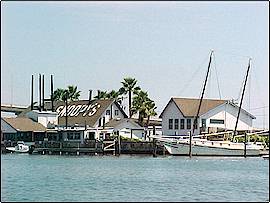
Snoopy's and the
bug-eye ketch
|
We got underway about 9:30. No hurry, we are on vacation. The wind was unsteady, and
onshore, about 0 - 15. Our speed by GPS ranged from 0 to 6 miles per hour. We
reached the JFK causeway that connects Padre Island to the mainland about noon. It used to be just Snoopy’s restaurant under the bridge, but now there are several places to eat and buy bait and supplies. There is a bug eye ketch, a sailboat with masts that slant backwards, tied up at Snoopy’s pier. It has been there for twenty years, ever since we have been coming down here, and we have never seen it move.
|
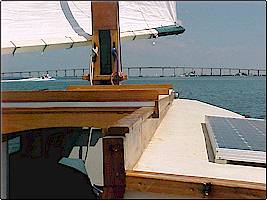
approaching the JFK
causway
|
Our little mouseboat (built from Gavin Atkin's design) followed faithfully. The GPS,
a new Garmin Mariner, turned out to have every navigation aid known to man (as promised), even some that we looked for in vain. Sailing on the Laguna Madre is interesting. Once just a wide shallow body of salt water between the mainland and the barrier islands, it is now host to the ICW or Intracoastal Waterway. Naturally only a few feet deep, it has been dredged to a depth of about
12 feet by one or two hundred feet wide to accommodate occasional barge traffic. The problem for sailors is that the dredged material (spoils) lies inches under the surface at the edges of the channel, invisible except to depth finders and the unwary keel, leeboard, or
propeller. You have to watch the markers and stay between them, and as easy as that sounds, it can be tricky with the wind pushing the boat sideways as you sail along. Best to point upwind a bit.
|

anchored at
Shamrock Island
|
A mile or so past the bridge, we came into Corpus Christi Bay. It is a good sized bay, and mostly 6-8 feet deep overall, making carefree sailing possible. Not that we didn’t keep an eye on the depth finder. We were heading for a small island in the southeast corner of the bay called Shamrock Island. Instead of formal charts, we have used Top Spot maps for our last two trips. The new editions have thorough GPS information as well as indications of both above and underwater obstructions. They also give advice about where and when to catch all the popular fish. The GPS is pretty amazing. Little islands look remarkably similar across the water, but latitude and longitude stay right where they are supposed to. We took the sails down and sailed into a small circle of a cove that we immediately named Paradise. A larger sailboat was anchored a ways off–we talked with the owners later and they were jealous that our fold up leeboard and shallow draft allowed us to anchor where we did.
|
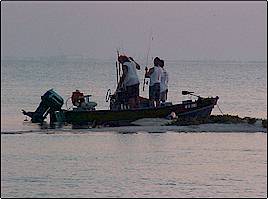
these fishermen had
no luck either
|
That evening, we paddled the Mouseboat over to the shore of the island and walked around. It felt good to use our legs after being on the boat all day.
We took our fishing poles and our new casting net. We bought a smaller diameter one for this trip, thinking that it might be easier to throw. Wrong. Invariably, it folded across the middle and landed in the water. Later, I heard that particular technique described as a “taco throw”.
We tried some of our artificial lures. I suspect the fish were laughing underwater. We caught weeds. The next morning, a boat with three fishermen was sitting in the same spot. Irony would dictate that they should be hauling in one fish after another, but they had no luck and soon motored away.
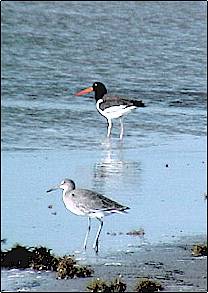 Instead of fresh fish, we ate canned meat and brocolli for dinner. Tomorrow in Port Aransas we will buy some bait. Instead of fresh fish, we ate canned meat and brocolli for dinner. Tomorrow in Port Aransas we will buy some bait.
Later, we tested our shower set-up in the self-draining cockpit. Our isolated anchorage made this possible. We had brought our old stainless steel sprayer that we used to take to the beach to wash the sand off the kids before we put them to bed at night. We would perch them one by one on an overturned bucket, strip them down, and one of us would spray off the sand and salt. The other would dry them off, and carry them over to the van where they would sleep in the back. The trip could last a few days longer with that little bit of organization. I have to say, I think we need a different shower head. Chuck says he thinks a kitchen sink sprayer might put out a bit more water. Still, it was way better than no shower at all. At exactly sunset, the mosquitoes moved in. How do they know that? We retired to the
cabin to read away the evening, lights courtesy of the solar panel that had been charging our battery all day.
Sunday, September 16
|
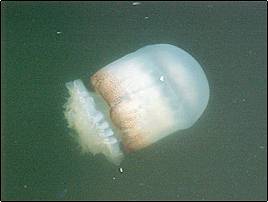
jellyfish
|
We woke up in paradise, but the day quickly turned sour. Chuck says the cruise from hell, but really just that one day was BAD. Our almost new Honda outboard took us out of the cove. We had a short stretch of shallow water to cover (3-4 feet), and then through a short channel into the ship channel. Five minutes after the motor started, it quit. Chuck pulled on the cord until he had blisters on his hand. He took the spark plug out and heated it with the stove. He checked to see that we had a spark, and primed the thing. Nothing worked. We watched the jellyfish cross beneath us, each and everyone of them seeming to have his or her own
separate destination in mind. The wind slowly began to pick up, and we decided to try to make it through the channel under sail. The
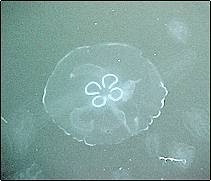 leeboard was kicked up once when we hit a shallow spot, but Chuck pulled it down, and we
continued on into the ship channel and intersected with a huge barge. We pulled over to one side, and still had plenty of water. The channel is about 50 feet deep in the middle, and a good depth extends outwards. Things looked good. Then the wind changed. Now we had to tack. We went back and forth, but soon realized we were gaining no ground. Actually, we were losing a bit of ground. We figured we were about 4 miles from Port Aransas. So close, and so far. And it was about there that we noticed our mouseboat was missing. We
thought we had last seen her when we were about to come through the channel from the bay into the Ship Channel. Had she let go in the bay or after we came through the pass? We wanted to go and look right then, but without the motor we were helpless. The day had gone from bad to WORSE. leeboard was kicked up once when we hit a shallow spot, but Chuck pulled it down, and we
continued on into the ship channel and intersected with a huge barge. We pulled over to one side, and still had plenty of water. The channel is about 50 feet deep in the middle, and a good depth extends outwards. Things looked good. Then the wind changed. Now we had to tack. We went back and forth, but soon realized we were gaining no ground. Actually, we were losing a bit of ground. We figured we were about 4 miles from Port Aransas. So close, and so far. And it was about there that we noticed our mouseboat was missing. We
thought we had last seen her when we were about to come through the channel from the bay into the Ship Channel. Had she let go in the bay or after we came through the pass? We wanted to go and look right then, but without the motor we were helpless. The day had gone from bad to WORSE.
|
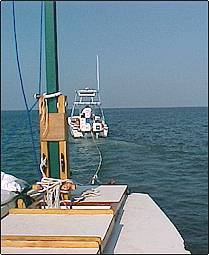
Pearl under tow
|
Our daughter Audrey was meeting us that afternoon in Port Aransas. She was going to take Chuck back over to Bird Island Basin to pick up our truck and bring it back to Port A. After another thirty minutes of trying to start the motor, Chuck called the Coast Guard. They determined that it was not a genuine emergency, and told him they would send out a private towing boat. He showed up with three small children, told us not only was the wind against us, but also the incoming tide. He pulled us carefully and efficiently to a berth at the public dock. Chuck was worried that he would charge us some huge amount of money, but he charged us for one hour of his time even though it took a little longer than that. He also put us in touch with a local fellow who came and looked at our motor, and found it full of water. Boy, did we feel stupid. We had saved the gas we had leftover from our trip to the
Midwest messabout in Illinois. Dumb Dumb Dumb. Chuck said I could demote him from first mate to swabbie, but I should have known better too.
|
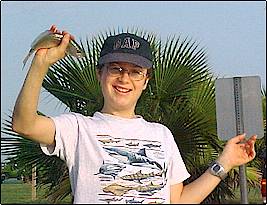
Audrey with a
Croaker
|
Our daughter came just as we were tying up, and we went and ate, and then Chuck and Audrey went and picked up our truck. While they were gone, I met the couple two slips down. They were from Wyoming and had come with their boat to fish offshore. They were catching ribbonfish right next to their boat to use for bait the next day. When Chuck and Audrey came back, they had picked up some bait, and we all caught more ribbonfish and gave them to our neighbors. Audrey got a big kick out of fishing. Along with the
Ribbonfish, we caught a Red Drum, some Croakers, and an ugly little
Skulpin.
Monday, September 17
|

Chuck trying to
start the *&#%$ motor
|
The next morning, we put tiny hooks on, and caught a dozen little
Seaperch with leftover breakfast sausage. We gave them to our neighbors for bait just before they headed out.
Audrey went into Corpus to check out the museums and the state Aquarium. We spent the morning on the motor and with the help of the mechanic had it going by noon. We drove to Rockport for new spark plugs, and also to check out the harbor, since we had never stayed there. Later, when Audrey returned, the three of us had a delicious seafood dinner at Pelican’s Landing in Port A., followed by a long walk on the beach.
Tuesday, September 18
|
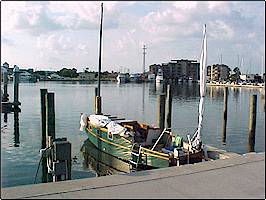
Pearl in Port
Aransas
|
Audrey decided she would rather get home to her boyfriend than go with us to look for our mouseboat. I think she was a little worried about getting seasick. Before we left, she had given me a homeopathic remedy for motion sickness. I normally take one Dramamine first thing in the morning when we are sailing, and that takes care of motion sickness, but they do make me sleepy. So far, the homeopathic remedy–tiny white pills that taste like sugar–had worked. No drowsiness, either.
We headed back up the channel, retracing Sunday’s route. I scanned both shores with the binoculars. Lots of birds
and sea wrack and other debri, but no mouseboat. Our little boat could have gone just about anywhere. Without some specific knowledge of wind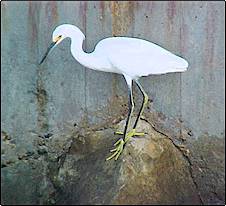 and currents, we would have found her only with blind luck. We decided to make for Rockport, 20 miles away. The wind had picked up to 15-20, and the GPS showed our speed under sail at 7.3 in the gusts. A real sleigh ride in the protected waters of the ICW. I was worried about the mast, and Chuck was worried about the rudder. Chuck could not seem to trim the sails to eliminate the weather helm, and we were thinking about reefing, but we had never done
that. About then we hit Aransas bay and a 2-3 foot chop, so we dropped the sails and motored the final 3 miles to Rockport Harbor. Got there at 4:45, just in time to register and get the Holy Grail, the shower code. Dinner, shower, grocery store, in that order. There is an HEB supermarket a short walk from the Harbor in Rockport. and currents, we would have found her only with blind luck. We decided to make for Rockport, 20 miles away. The wind had picked up to 15-20, and the GPS showed our speed under sail at 7.3 in the gusts. A real sleigh ride in the protected waters of the ICW. I was worried about the mast, and Chuck was worried about the rudder. Chuck could not seem to trim the sails to eliminate the weather helm, and we were thinking about reefing, but we had never done
that. About then we hit Aransas bay and a 2-3 foot chop, so we dropped the sails and motored the final 3 miles to Rockport Harbor. Got there at 4:45, just in time to register and get the Holy Grail, the shower code. Dinner, shower, grocery store, in that order. There is an HEB supermarket a short walk from the Harbor in Rockport.
Wednesday, September 19
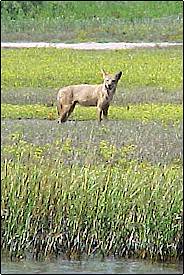 The HEB opened at 6, and we were there with our ice chest. They also serve breakfast in the deli, so we had that first, then filled our ice chest and carried it back to the boat. We carry two ice chests–fill one with ice and use it to keep the food chest supplied. That turned out to be a pain, as the only spot the ice filled chest would fit was in the small space ahead of the cabin. We are working on a new plan to turn one of the spaces under the seats in the cockpit into an insulated ice space.
The HEB opened at 6, and we were there with our ice chest. They also serve breakfast in the deli, so we had that first, then filled our ice chest and carried it back to the boat. We carry two ice chests–fill one with ice and use it to keep the food chest supplied. That turned out to be a pain, as the only spot the ice filled chest would fit was in the small space ahead of the cabin. We are working on a new plan to turn one of the spaces under the seats in the cockpit into an insulated ice space.
Off to Cedar Bayou. Cedar Bayou is not the Louisiana kind of bayou
with Cypress trees lining the banks and alligators lurking just beneath the surface. (I
would have to revise this later.) This bayou is lined with tall grass and low bushes and has deer and coyotes prowling the banks. We saw the deer the first time we were there, and this time it was a coyote who stared at us as we motored past. Thousands of seabirds inhabit the area, which is next door to the Aransas Wildlife Refuge–winter home of the endangered Whooping Crane. They would not be flying in until late October or November, and we plan to go back and check them out over Thanksgiving. The bayou is the cut between San Jose Island and Matagorda Island, like Padre, both barrier islands between the Gulf and the Laguna Madre.
|
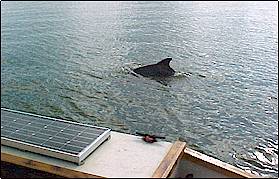
Porpoise off the
starboard beam
|
We left Rockport at 7, and cut across the bay to a spot between the spoils that put us in the ICW. We put the sails up, but the wind was light, and we supplemented with the motor. I guess we were impatient. There was what looked like a peregrine falcon swooping and diving along the banks of the refuge. Egrets and herons went about their solitary fishing. At some point, we were joined by four porpoises. (Porpi?) We always see them at the coast, but these guys swam along with us, surfacing often and looking at us sideways. They stayed with us for about five minutes until they tired of us and went off in a different direction. They were so close, we could almost touch them.
|
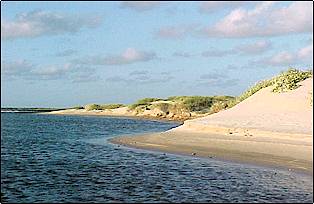
the anchorage at
Cedar Bayou
|
Soon, we turned out of the ICW into Mesquite bay, where there is a channel marked with tall poles- the path to Cedar Bayou.
The water depth held at about 4 feet until we got to the upper reaches of Cedar Bayou. We had a hard time following the channel as it was poorly marked, and our memories of our first trip were hazy at best. We were churning up mud with the motor, and we passed one fisherman who shook his head as if to say we were idiots, but we were determined to reach our previous anchorage. Looking back, it was a bit reckless, and we did get stuck once, but we just hopped out and then the boat floated fine with us leading it over to the shore where we set our anchor. And the trip in helped us scope out the channel for the trip out.
|
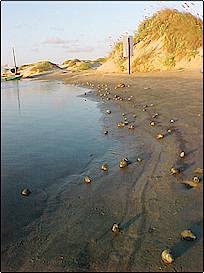
Hermit Crabs on
patrol
|
Things had changed. The water no longer flowed between the bayou and the Gulf. On our first trip there were maybe a dozen fisherman, standing in the cut, fishing the flow of fish between the two bodies of water. Now it was just sand. This time we had the spot to ourselves. We walked over to the Gulf side, about 100 yards over the dunes. Looking down the beach we could see a boat that looked as if it was beached. That would be our walk the next morning. We had a late lunch and just lazed around. I watched the hermit crabs patrolling the edge of the shore. They were playing a little game that involved spacing themselves out on the beach like little pearls that needed to be strung. The birds entertained us. Small shorebirds would sit quietly on the island across from the boat until they decided to all swoop up into the sky, fly around in random patterns for a while, then come back down where they had started. The brown pelicans mostly sat watching and grooming and sleeping. After dinner, the mosquitoes arrived, but Chuck dosed himself with repellent and fished from the cockpit. He caught hardheads (a saltwater catfish), small red and black drum, and Croakers.
|
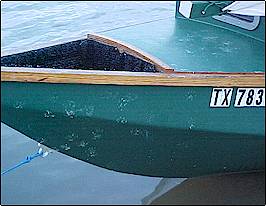
Mr. Raccoon's muddy
paw prints
|
Not long after we turned in, I heard footsteps on the top of the boat. A racoon had climbed aboard. Chuck grabbed his light and the camera and tried to get a picture, but the racoon ran away. I woke up later, about 4:30 a.m.. Footsteps again. I looked up through the hatch over our head, through the screen we had put in for air, and there was the silhouette of a head with two pointy ears looking down at me. I shrieked, he squeaked and ran. I was running little movies in my head involving raccoons who crashed through the screen in the hatch into our bed, and the three of us thrashing around with sharp little frantic raccoon claws in the mix. Chuck jumped out into the cockpit and tried again for a picture, but it was too dark.
Thursday, September 20
|
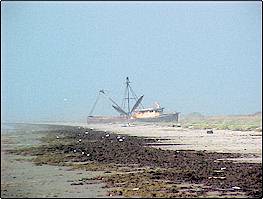
rusting shrimper on
the beach
|
Hiked down the beach to check out the boat. I think it is stuff like
this that brings me back here again and again. It was a Gulf shrinper, a big boat stripped of it’s motor and turning slowly to rust. The arms were out, and I wondered how long it would be before they toppled off into the sand. Nothing seems to last long in the salty, sandy air of the coast. Chuck climbed up inside and poked around in the cabin. We speculated about what might have happened–a storm, a mutiny, or someone just asleep at the wheel. And why didn’t they just pull it back out off the beach? The surf here is generally small, and it was not as if it had crashed up onto rocks. Little mysteries. Like why do the jellyfish get washed up on the beach? Saw a bird we’d never seen before. He turned out to be an American Oystercatcher.
 Back at the boat, we discovered company. Three fishing boats had maneuvered the shifting channel into the bayou, and fishermen with all the right gear were casting for trout and redfish.
These guys had the mesh clothing to keep them cool without getting sunburned and the neck protector hats covered with lures. They were wearing the water walking boots that will protect you from a sting ray barb or the pinch of a blue crab. I liked the idea of those. We’d seen a sting ray earlier, lurking in the shallows. One thing I do not like to do is jump off the bow of the boat to pull us into the shallows when I cannot see the bottom of the water I am jumping into.
Back at the boat, we discovered company. Three fishing boats had maneuvered the shifting channel into the bayou, and fishermen with all the right gear were casting for trout and redfish.
These guys had the mesh clothing to keep them cool without getting sunburned and the neck protector hats covered with lures. They were wearing the water walking boots that will protect you from a sting ray barb or the pinch of a blue crab. I liked the idea of those. We’d seen a sting ray earlier, lurking in the shallows. One thing I do not like to do is jump off the bow of the boat to pull us into the shallows when I cannot see the bottom of the water I am jumping into.
|
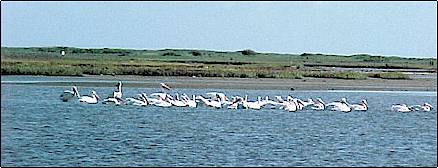
White Pelicans
|
Anyway, the fish were not biting, and we were soon alone again. We rigged our sunshade for the heat of the day, and after lunch, spent the afternoon reading and sketching, and watching the birds. A group of white pelicans had arrived. Their behavior is quite different from that of the brown pelicans. The whites hang together on shore and in the water. In the water they move as if connected by strings. They have a curious little “dance”. They will all be moving in one direction, and then the leader will turn, and the group forms into a circle. Tails in the air, heads in the water, everybody feeds. Then all turn to move along again. I described this to a fellow back home, and he confirmed what we suspected; they are herding fish. It is a beautiful routine. That plus the random flights of the smaller birds kept me entertained during the afternoon heat.
Later, another boat motored in, and this fellow set up camp on the shore. Chuck had climbed down in the cabin to write and I was thinking about dinner when the silence was shattered by,
“Alligator! Alligator!”

We zipped out into the cockpit, and there he was, swimming slowly past Pearl as if Pearl was a rock on the beach. At least 8 or 10
feet or, I don’t know, 20 feet long, with a massive head, and that long bumpy ridge of back moving right behind. Now I had to add an alligator to my raccoon movie, but I was pretty sure this fellow could not climb up into the cockpit of our suddenly small, flimsy boat. Chuck confirmed that, or at least said he was pretty sure. We decided to stay out of the water. Our new neighbor was concerned. He was planning to run back into Rockport to pick up a fishing buddy, and coming into the bayou, he’d had to jump out and pull his boat off a sandbar. He was wishing he had not seen our alligator buddy. Then again, he did not want to leave his friend standing on the dock. He headed out and we watched closely. He took things slowly, and stayed in the deep parts (2-3 feet), and did not have to leave his boat. I was pretty sure we were both committing his route to memory for when we headed back out.
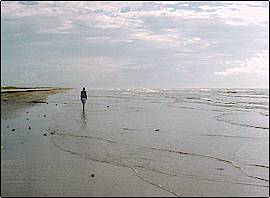 That evening, we walked the other way up the beach from the shrimp boat. The wildness of this place is amazing. The pounding surf, the howling wind, and all overlaid with the cries of the birds. Sand, sea, and sky, and all in motion. Even the sand is invisibly shifting in the wind. The tracks of coyotes, raccoons, crabs, and birds print the surface. Timeless, much the same as it would have appeared a thousand years ago. Except for the plastic beach flotsam. That evening, we walked the other way up the beach from the shrimp boat. The wildness of this place is amazing. The pounding surf, the howling wind, and all overlaid with the cries of the birds. Sand, sea, and sky, and all in motion. Even the sand is invisibly shifting in the wind. The tracks of coyotes, raccoons, crabs, and birds print the surface. Timeless, much the same as it would have appeared a thousand years ago. Except for the plastic beach flotsam.
Friday, September 21
|
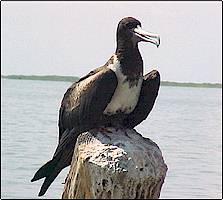
Frigate Bird
|
We were feeling a need of civilization, specifically showers, and maybe even some air conditioning. We eased our way out of the bayou, and had no trouble in the shallows. No sign of Mr. Alligator, and the birds feeding along the shore seemed unconcerned. Saw several small groups of Roseate Spoonbills, and one pair of what I am sure were Wood Storks. In Mesquite Bay we spotted a couple of Frigate birds, sitting on the posts that mark the channel. They were both females, we think, and each had one wing stretched out. We did not seem to alarm them as we did the brown pelicans. Back in the ICW, we decided there was still not enough wind to raise sails. And what little there was died completely by the time we reached Aransas Bay. I’ve never seen the coast so calm. The surface of the water was like an old mirror, not quite flat, but still glassy. We motored all the way to Rockport, tied up, showered, walked over to the supermarket, bought a paper and cold drinks, and sat in the deli booths, cool and clean.
 We read about the bridge collapse at Port Isabel. When I had called our son to tell him about being towed, he wanted to know if we’d been the one who hit the bridge. He knew we weren’t anywhere close, but he wanted to give us a hard time. Now we knew why we had seen a ferry boat heading that way as we left Bird Island Basin the Saturday before. Most of the articles concerned the Sept. 11 events.
We read about the bridge collapse at Port Isabel. When I had called our son to tell him about being towed, he wanted to know if we’d been the one who hit the bridge. He knew we weren’t anywhere close, but he wanted to give us a hard time. Now we knew why we had seen a ferry boat heading that way as we left Bird Island Basin the Saturday before. Most of the articles concerned the Sept. 11 events.
Cooled down and rested, we walked around town looking for a place to have dinner. Both of us zeroed in on the Mexican restaurant. Chuck had fajitas and I had the special, green enchiladas. Yum. During the night, thunderboomers moved in. We had to close the forward hatch to keep the rain out.
Saturday, September 22
|
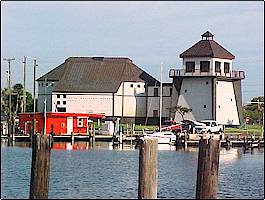
the Rockport Maritime
Museum
|
It was still raining on and off Saturday morning. We had already decided to visit the two local museums. Rockport has a neat Maritime museum. I had been there several times, so Chuck went alone and I visited the Rockport Art center. Both are just a short walk from the harbor. They opened at ten, and I was done in twenty minutes. Two hours later, I started to wonder if Chuck had gotten lost. No, he was in boat lover’s heaven. They had videos of the La Salle boat La Belle rescue operation, including artifacts from the boat. When I went to look for him, he was on his way out, but still visiting with the volunteers at the desk.
|

the Lydia Ann
lighthouse
|
After lunch, the rain slacked off, and we headed back to Port Aransas. Once again, there was not much wind, so we motored. The five horse Honda is remarkably efficient, using tiny amounts of gas to propel us through the water. We also had a strong current going our way that almost doubled our speed. We took the southern route, through the Lydia Ann Channel. White Ibises were feeding along the banks. A coast guard raft passed us packed with teenage girls and boys.
One of the main landmarks is the old Lydia
Ann lighthouse, just north of Port Aransas. Crossing the ship channel to the harbor, we saw Saturday kayakers
somewhat precariously sharing the water with sport fisherman up in their flying bridges. An old ferry that had been converted into a bay fishing boat for tourists was nudging along the bank.
|
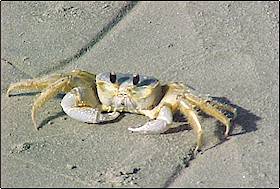
Sand or Ghost Crab
|
We had planned to stay another couple of days, but the harbormaster told us that the cold front that had been stalled in the midwest was barreling on down, so Sunday morning we loaded Pearl onto the trailer and drove north. On the way, we were already planning our next trip. We also talked about the things we would do to make our space more liveable and efficient. We could eliminate our clothing duffle bags with big mesh multi-pocketed things that would hang on either side of our cabin. That’s one of my assignments. We also need some sort of racks to hold books and magazines. Secure racks in the galley area could hold the utensils and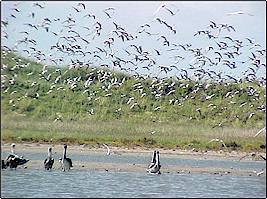 dishes we use every day, plus matches. We probably don’t need four 5 gallon water jugs, and besides, their size and weight made them awkward to deal with. Maybe three gallon jugs would be better. Basically, we want to find ways to have less stacking and unstacking to get to things, and to make the stuff we use every day easily accessible. We are still working on a way to make the bed easier to put together and take apart. Chuck jury rigged a scoop over the forward hatch which was wonderful for air flow, and we’d like a more permanent arrangement for that. The big sunshade for the cockpit was a last minute addition, but it was also wonderful, and we are thinking it would be a roll-up part of the bimini which also needs work.
However we end up changing the setup, we will definitely be back. dishes we use every day, plus matches. We probably don’t need four 5 gallon water jugs, and besides, their size and weight made them awkward to deal with. Maybe three gallon jugs would be better. Basically, we want to find ways to have less stacking and unstacking to get to things, and to make the stuff we use every day easily accessible. We are still working on a way to make the bed easier to put together and take apart. Chuck jury rigged a scoop over the forward hatch which was wonderful for air flow, and we’d like a more permanent arrangement for that. The big sunshade for the cockpit was a last minute addition, but it was also wonderful, and we are thinking it would be a roll-up part of the bimini which also needs work.
However we end up changing the setup, we will definitely be back. |
![]()